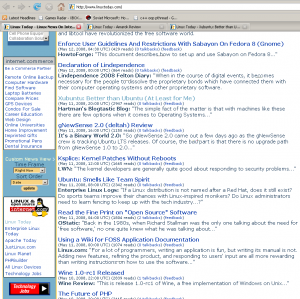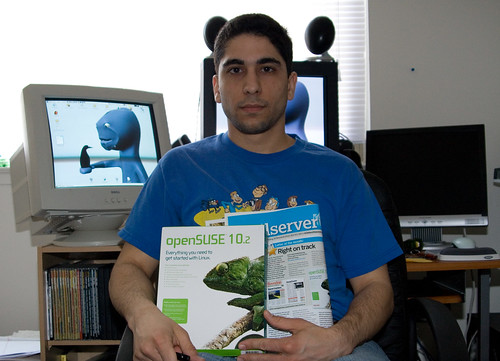Blender 2.46 Released! (Yesterday)
Blender 2.46 was released yesterday and it has a whole bunch of new features- mostly created to facilitate production of Big Buck Bunny. What I’m looking forward to the most is hair/fur rendering, any tools that make armatures easier to skin (the bane of my animation hobby!), a cloth simulator, and the improved sequencer which should allow most of the video editing to take place inside of Blender.
I’d love to play with it, but right now I’m working on some animation projects so I need to wait until at least Fedora comes out with the 2.46 rpm. Ideally also my FreeBSD render farm would also get updated. A lot of the new goodies like hair/fur rendering are not backwards compatible. Good job from the coding team and I hope to test it out soon enough.
History Meme
[emesa@mario ~]$ uname -a Linux mario.mushroomkingdom 2.6.24.5-85.fc8 #1 SMP Sat Apr 19 12:39:34 EDT 2008 i686 athlon i386 GNU/Linux [emesa@mario ~]$ history | awk ‘{a[$2]++}END{for(i in a){print a[i] " " i}}’ | sort -rn | head 176 ls 172 eog 81 ./makeSpiral.pl 80 cd 61 ./makefibonaccicollage.pl 58 mplayer 51 ./makePolar.pl 36 mv 28 flickr_views.py 24 exit
and root:
[root@mario ~]# history | awk ‘{a[$2]++}END{for(i in a){print a[i] " " i}}’ | sort -rn | head 193 ls 127 cd 102 exit 87 mount 77 yum 71 history 43 emacs 35 cat 20 rm 16 ifconfig Notes:
Microsoft DRM Metldown Redux
As I mentioned here, Micro$oft has provided yet another example of why digital restrictions management does nothing but hurt legitimate consumers. To remind you, this is when Microsoft turned off the servers for its ironically named “playsforsure” DRM system. These songs, which consumers would told, would play for sure on any digital media player containing the proper logo, will no longer play once August comes around and Microsoft turns off the servers which validate you as a non-criminal. I hope there’s a huge outcry that forces them to un-DRM all these songs and sounds the ultimate death knell for DRM.
Lightweight Linux Throwdown
I’ve used Damn Small Linux (DSL) quite a bit in the past. Before getting my laptop I used to use it to be able to get a Linux desktop at my in-laws’ house. I decided I wanted to try out some of these other lightweight Linux distros that everyone is always talking about. Even on Linux Outlaws they mentioned how they like some different light distros over DSL. Since I’ve used DSL so much, I decided to evaluate these other Linux distros based on how they compare to DSL.
Fedora 9 Release Story
Fedora usually has a wacky little story to go along with each release. Here’s the one for Fedora 9:
An ancient text prophesised this day would come, detailing the fate of all who are willing to accept what is offered to them:
http://docs.fedoraproject.org/release-notes/f9/index.html
And that day has come: the Computer said “I will convert these unbelievers, and now that I have Sulphur it will be easy.” At that, the heavens opened and burning Sulphur descended upon all the world, taking on many different forms.
Fedora 9 - Sulfur Released
If all goes well, then as this post appears at 1000, Sulfur will be released to the mirrors and available for download! Enjoy! If you download from scratch, be sure to use bit torrent so you can share the bandwidth.
On LinuxToday Yesterday
Yesterday, to my surprise, when I went to LinuxToday, I found that I had been aggregated!
For those (like my wife) who don’t know what this means, it’s more or less the equivalent of a garage band being discovered and being invited to play at The Apollo. I’ve wanted to have my Linux-related blog posts aggregated on there for years. I’m happy to finally make it. I hope this means I’ll be there more often. Of course, I’m a little disappointed that this post was the one they chose to spotlight. I have had so many better written Linux-related articles. Oh well, better to get my blog out there and hopefully get posted more often than to never be posted at all.
Operating Systems and Sociology
Penguin Pete has started a very interesting view of what drives people to use certain operating systems. You may find part one a little heavy, especially if you don’t know the history behind it. Basically, Pete has been slammed quite a few times for his blasphemous viewpoint that Ubuntu is a watered down version of Linux that doesn’t always show users the true spirit of Linux. Part two is a witty, well written historical (and fanciful) acount of how we arrived at the current situation. The fractionalization of the three main OSes is the subject of Part Three.
My Top 10 Most Interesting Pictures
Flickr has a secret algorithm for producing a list of the most interesting pictures. So here are what Flickr thinks are my 10 most interesting pictures. Do you agree?
Eric the distro reviewer?
I’ve been reading so much about all these Linux distros and I’ve been curious what they’re all about. In particular, Mandriva’s been calling to me a lot because I think that, had Ubuntu not been around, I probably would have installed it on my laptop. I’ve certainly had a bit of interest in the distro. There’s also all these other strange distros like GOS and Foresight Linux that I everyone’s talking about. I find myself wondering what’s so different or great about these? As you’ve noticed recently, the pendulum on my blog has swung away from Blender and back towards Linux while mostly skipping over politics (there really isn’t much to be said there that hasn’t been said over and over on cable news). So you may notice some more reviews on here.





